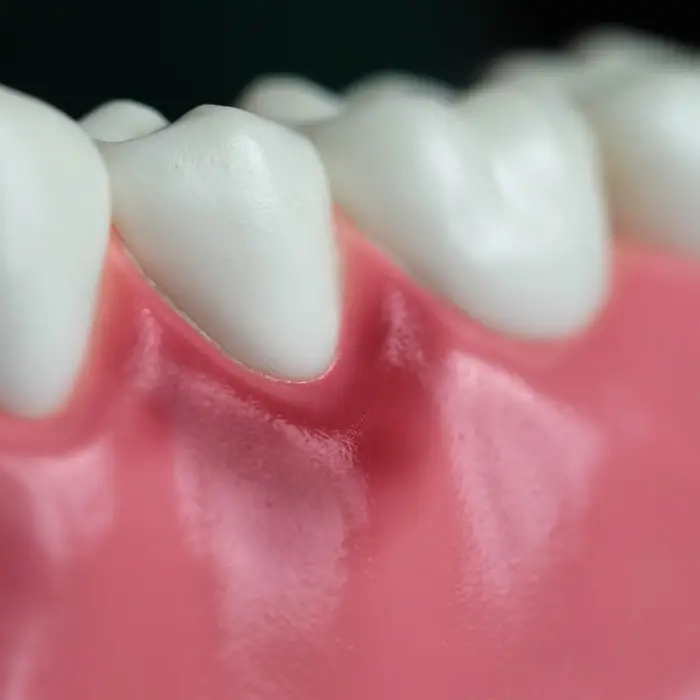Gingivitis
The reasons for gingivitis
Bad oral hygiene
The most common reason for gingivitis is inappropriate oral hygiene. During meals a thin layer of film is formed on our teeth, which consists of bacteria, this is the so-called dental plaque. If someone brushes his/her teeth erratically or the brushing is not efficient, this layer of plaque starts to become continuously thicker. Harmful bacteria multiply step by step, which damages the teeth and the surrounding tissues, the gums. This layer of plaque becomes hard after a little while and thus tartar evolves. This thickened, hard layer can no longer be removed by brushing teeth at home – no matter how efficiently it is done. The pathogens found in the bacteria can even cause caries or the constant inflammation of the gum tissues.
Smoking
Smoking doesn’t only continuously weaken the protective and self-healing mechanism of the body, but unfortunately it has a detrimental effect on the tissues found in the oral cavity, including the tissues of the gums. As a consequence, the gums are more prone to inflammation due to the effects of smoking.
Apart from this, in many cases the role of other general organic factors are also significant in the evolvement of gingivitis, such as genetic, hormonal and immune system processes, diabetes, eating disorders, lack of vitamins, certain medications, hereditary diseases.
The symptoms of gingivitis
The symptoms of gingivitis
- Red, swollen, strained, sensitive gums. Healthy gums are light pink.
- Bleeding of the gums, especially when brushing: healthy gums do not bleed.
- Unpleasant breath: the bacteria connected to gum disease release unpleasant odours during breaking down of particles of food in the mouth. Bad breath is an embarrassing and unpleasant situation and this could be a warning that gum disease is evolving.
The consequences of gingivitis
If the gums are inflamed, this in itself does not coincide with conspicuous symptoms. Often at this stage we do not pay adequate attention to this. However, if we do not treat gingivitis, it will have grave consequences sooner or later. Inflammation can spread from the gums to the periodontal tissues and can also reach the bony matter of the jaw, and at this we are talking about periodontitis. The gums start to gradually retract from the teeth, the evolvement of tartar becomes more and more intensive. A gap starts to form between the teeth and the gums, which can deepen continuously, this is what we call a pocket. In this ever-deepening pocket, bacteria get lower and lower, reach the bone matter which supports are teeth. This bone tissue becomes soft as a result of the inflammation, the teeth can start to move and in the absence of appropriate treatment, they may even be lost.
The treatment of gingivitis
Gingivitis is a disease which can be treated well, stoppable and reversible. The first step for this is the professional cleaning of the teeth, the removal of tartar. In more advanced inflammatory cases, for patients suffering from periodontal disease, the removal of tartar every 3 month is recommended. This must be done every time at a dental surgery by a trained dental hygiene professional. You should not try to crack off the tartar at home by all means. Antibacterial mouthwash, pencils or other supplementary therapeutic gum treatments may be necessary, It is very important to master proper and thorough tooth brushing at home, the dental hygienist can help you with this as well, who can assist you in developing the correct home tooth care routine, tailored to your needs. It is worth starting to treat gingivitis on time as by this the evolvement of periodontal disease and the potential ensuing loss of teeth can be prevented.
The prevention of gingivitis
If tooth brushing is regular and thorough, which includes the use of dental floss and interdental brushes as well, - then you have made a huge step in order to prevent gingivitis. For this disease is due to the bacteria dwelling in the pellicles – the plaque layer - forming on the teeth. It is important to have regular, at least 6-monthly dental check-ups, most of all the removal of tartar, during which the professional is able to perfectly clean the teeth, even in all hard-to-reach areas. In addition to this, it is worthwhile not to smoke, to pay attention to varied eating and also to avoid sugary foods and drinks which damage the teeth.
Gingival atrophy
We talk about gingival atrophy when the gum starts to come off the tooth and the roots are left uncovered underneath. It may look as if the tooth was a little bit stretched, became longer and we can feel a tiny gap at the juncture of the tooth and the gum, along the gums. A further symptom of gingival atrophy is sensitive teeth. Gingival atrophy is relatively frequent, but if it is discovered on time, we can stop it from becoming worse.


